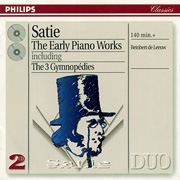
Satie—The Early Piano Works
Reinbert de Leeuw
1998: Philips Classics/Duo 289 462 162-2
CD 1
Gnossiennes
Ogives
Gymnopédies
CD 2
Sarabandes
Sonneries de la Rose-Croix
Pièces froides
4 Préludes
Includes “Disquiet and Dislocation,” an article by Max Harrison.
I’m hardly qualified to comment on the compositional qualities of these pieces, so I’ll just note (more as a listener than as a pianist, which I also am) that Satie’s pieces reaches me like a broken music-box which plays tunes that come out slightly off and slightly differently each time their intended melody repeats, with the effect that it’s simultaneously somewhat charming, disturbing, and generative of further reflection and perhaps developing thought.
As a pianist I do enjoy playing these pieces, more because of their sonorous vignettes than because of their obvious technical un-challenging-ness, which I admit does appeal to me too. Continuing with that music-box analogy, though, playing them feels as though I’m turning the crank of that music-box rather than delivering the performance of the written work, as each new chord shift comes as a bit of a surprise to me. If I studied the pieces, practiced and memorized them, and absorbed them as wholes, as I would have done to some extent as a piano student, perhaps I would have a different sense of them, but this is where they land with me today.
Comments © 2015 Mark Ellis Walker, except as noted, and no claim is made to the images and quoted lyrics.